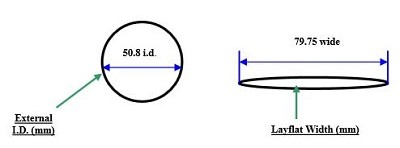Heat Shrink Sizing Guide


Cable management is simple enough, right? Buy some heat shrink tubing, maybe a few zip ties, and you’re done. But, like everything, buying the right cable management materials isn’t that simple. Heat shrink in particular can be tricky, especially when you consider what material, thickness, shrink ratio, diameter, flat width, and expandability you need for your wiring or cable bundles. All of that is the reason why you need this heat shrink sizing guide.
In this guide, we’ll talk about the different dimensions to consider with heat shrink tubing sizes, what they mean, and how to determine what size of heat shrink is right for your cable management needs.
Heat Shrink Tubing Sizes: The Dimensions
Let’s start with a little bit of math. Most of these terms sound a lot more complex than they actually are. They’re easy to tell apart, once you know the lingo. Let’s get started.
1. Circumference vs. Diameter
Put simply, the circumference of an object is the distance around a circle. So, when you’re looking at a cylinder, the round end at the top and bottom can be measured to find their circumference.
When it comes to heat shrink tubing sizes, the circumference is the measurement of the open ends when they are fully expanded. By pressing together the two sides of a flat piece of heat shrink tubing, you can even measure the circumference yourself!
Diameter, on the other hand, is the distance straight across a circle. When the heat shrink tubing is fully expanded, the distance from one side of the open end to the other is the diameter.
Both of these measurements are important to know when considering heat shrink tubing sizes. In order to fit a bundle of cables, wires, or other materials into your heat shrink tubing, you’ll need to know how much space you have to work with. By using both of these measurements before you buy, you won’t have to think twice about getting the right size.
2. Flat Width vs. Diameter
Now that we know what we mean by the diameter of heat shrink tubing, let’s compare that measurement with flat width. The flat width of heat shrink tubing is the distance from one side to the other of one open end of the tubing while the heat shrink is flat.

Heat shrink tubing arrives flattened for easier and more efficient shipping. Given what we’ve learned about diameter, we can assume that flat width would be the same distance, right? Wrong.
Flat width measures the distance between the two sides of the opening of heat shrink tubing when they are the furthest apart from each other. When fully expanded, the opening of heat shrink tubing actually contracts slightly, meaning that these two measurements aren’t the exact same.
The moral of the story: take both measurements into account when trying to figure out the right heat shrink tubing sizes for you.
3. “Shrink Ratio”
Well, this is the one you’ve all been waiting for. This is one of the only measurements that is specific to heat shrink tubing and plastics.
A Shrink Ratio is a measurement of how much a piece of heat shrink tubing will contract once it is introduced to heat. This measurement is generally expressed by a ratio (2:1, 3:1, etc.). The ratio will determine how much the heat shrink tubing will, well, shrink. For example, 2:1 heat shrink tubing will reduce at a ratio of 2 to 1, so half it’s size. 3:1 heat shrink tubing reduces to a third of its size, and so on and so forth.
This measurement is crucial when purchasing heat shrink. Too small a ratio, and the heat shrink could tear or crush the materials inside the tubing. Too large, and the heat shrink won’t work at all.
So, What Size Do You Need?
Using all the information you’ve learned thus far, you’re now ready to buy some heat shrink tubing. To learn more about heat shrink tubing sizes or other topics, visit our blog and learning center.
To purchase heat shrink tubing or other cable management materials, visit us at BuyHeatShrink.com.














